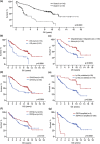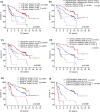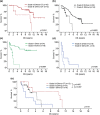Combination genetic signature stratifies lower-grade gliomas better than histological grade
- PMID: 26369702
- PMCID: PMC4673237
- DOI: 10.18632/oncotarget.4928
Combination genetic signature stratifies lower-grade gliomas better than histological grade
Abstract
We studied if combination genetic signature potentially stratifies lower-grade gliomas better than histology by investigating 214 lower-grade gliomas for IDH1/2 and TERTp mutations, 1p/19q codeletion and EGFR amplification as to their impact on prognostication. Prognostic association of grading was independent of other prognostic variables including age, histological type, IDH1/2, 1p/19q and TERTp status. No single marker, including IDH1/2, superseded grading in prognostication, indicating grading was still a very important tool. Prognosis was most favorable in 31.7% of patients with IDH1/2 mutation and either 1p/19q codeletion or TERTp mutation (IDHmut-OT), intermediate in 45.8% of patients with IDH1/2 mutation only (IDHmut) and 16.9% of patients without any of the alterations (IDHwt), and poorest in 5.6% of patients with wild-type IDH1/2 and either TERTp mutation or EGFR amplification (IDHwt-ET). Our results suggested not all IDH1/2 wild-type lower-grade gliomas are aggressive and additional biomarkers are required to identify glioblastoma-equivalent tumors. Multivariate analysis revealed independent prognostic values of grading and genetic signature. Grade II IDHwt-ET gliomas exhibited shorter survival than IDH1/2 mutated grade III gliomas, suggesting combination genetic signature potentially superseded grading in prognostication. In summary, biomarker-based stratification is useful in the diagnosis and prognostication of lower-grade gliomas, and should be used together with grading.
Keywords: 1p/19q; EGFR; IDH1/2; Pathology Section; TERT; glioma.
Conflict of interest statement
The authors declare no conflict of interest.
Figures





References
-
- Aldape K, Simmons ML, Davis RL, Miike R, Wiencke J, Barger G, Lee M, Chen P, Wrensch M. Discrepancies in diagnoses of neuroepithelial neoplasms: the San Francisco Bay Area Adult Glioma Study. Cancer. 2000;88:2342–2349. - PubMed
-
- Brat DJ, Prayson RA, Ryken TC, Olson JJ. Diagnosis of malignant glioma: role of neuropathology. J Neurooncol. 2008;89:287–311. - PubMed
-
- Kros JM, Gorlia T, Kouwenhoven MC, Zheng PP, Collins VP, Figarella-Branger D, Giangaspero F, Giannini C, Mokhtari K, Mørk SJ, Paetau A, Reifenberger G, van den Bent MJ. Panel review of anaplastic oligodendroglioma from European Organization For Research and Treatment of Cancer Trial 26951: assessment of consensus in diagnosis, influence of 1p/19q loss, and correlations with outcome. J Neuropathol Exp Neurol. 2007;66:545–551. - PubMed
-
- Bourne TD, Schiff D. Update on molecular findings, management and outcome in low-grade gliomas. Nat Rev Neurol. 2010;6:695–701. - PubMed
Publication types
MeSH terms
Substances
LinkOut - more resources
Full Text Sources
Other Literature Sources
Medical
Research Materials
Miscellaneous

